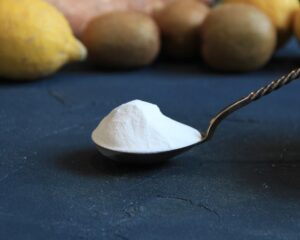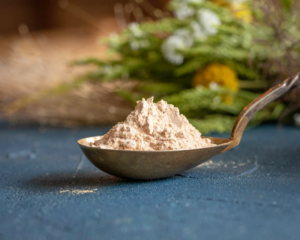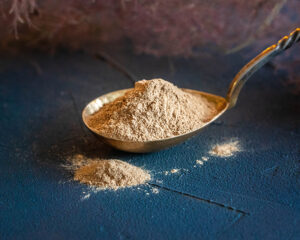Organic Guar gum
From 1.60€
Guar gum is obtained from the seeds of the guar plant Cyamopsis tetragonoloba, native to India and Pakistan. Guar gum is similar in properties to gingerbread gum (made from powdered poppy seeds). Only if guar gum dissolves quickly in water at room temperature, but it needs to be heated to at least 85 °C to dissolve. Guar gum is a natural thickening and stabilising agent (E412) widely used in the food, pharmaceutical and cosmetic industries. In addition to its culinary uses, its potential health benefits have attracted attention.
The production process of guar gum consists of several steps. The guar plant is grown for its seeds. When the plant matures, the pods containing the seeds are harvested. The harvested pods are beaten to extract the seeds. The seeds are then cleaned of any dirt or debris. The seeds of the purified guar plant are divided into two, called endosperms. Endosperms are rich in galactomannan, a polysaccharide that makes up the bulk of guar gum. Endosperms are ground into a fine powder using special equipment. This process helps to separate galactomannan from endosperms. The powder is mixed with water to form a semi-liquid mixture. The galactomannan in the powder coagulates and starts to swell. The galactomannan is then separated from the insoluble parts of the seed. The separated galactomannan is dried to obtain the final product – guar gum.
Benefits of organic guar gum:
Seeding:
Guar gum is a soluble fibre that can help improve digestion.
When consumed, it forms a gel-like substance in the intestines that promotes regular bowel movements and prevents constipation.
Research suggests that guar gum may help reduce the symptoms of irritable bowel syndrome (IBS) and improve overall bowel function.
Blood sugar regulation:
For people with diabetes or insulin resistance, plain guar gum may be useful in regulating blood sugar levels.
The fibre content of guar gum slows down the absorption of carbohydrates, which improves glycaemic control after meals.
Cholesterol management:
Research suggests that organic guar gum may help lower levels of LDL cholesterol, the “bad” cholesterol, which is associated with an increased risk of heart disease.
Its ability to bind bile acids in the intestine helps reduce cholesterol absorption.
Attention! Although organic guar gum is safe for most people, excessive consumption can cause side effects such as bloating, gas and abdominal discomfort. It is very important to use guar gum in moderation and to consider individual needs.
Usage: Guar gum improves the texture and volume of baked goods such as pastries, cakes and pies, resulting in better quality and longer shelf life. Guar gum is commonly used in plant-based dairy and yoghurt products to achieve a creamy consistency and to prevent separation of ingredients. Guar gum is an excellent thickener for both hot and cold dipping sauces, creating a uniform texture. It is used in desserts and ice cream. Guar gum can be used as a substitute for gelatine with a neutral taste and smell. Kfor rich foods (sauces, stews, puddings), it is recommended to use 1-3 teaspoon of powder per 1 litre of liquid, or 1-3 teaspoon per 1 litre of liquid.for sweet foods (salad dressings, ice cream, puddings) 1-2 teaspoon powder per 1 litre of liquid.
For regular use, guar gum is safe for most people, but it is not recommended for use for more than two years in a row. For pregnant women, guarkummi be safe to use for up to 4 weeks in a row. There is not enough reliable information to know whether guar gum is safe to use while breast-feeding. Guar gum is safe for children aged 4 years and older.
Sources:
https://www.healthline.com,
https://www.ncbi.nlm.nih.gov,
https://www.webmd.com
NB! The information provided here should not be interpreted as a recommendation for treatment or other types of health problems. We encourage you to make personal health decisions after evaluating different sources of information.
100% organic guar gum
Energy 843 kJ / 209 kcal
Fats 0,6 g
- of which saturated fatty acids 0,2 g
Carbohydrates 1,0 g
- of which sugars 0,9 g
Fibre 88 g
Protein 5,7 g
Salt 0 g
Store in a cool, dry place.











